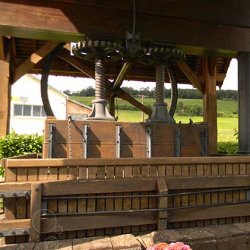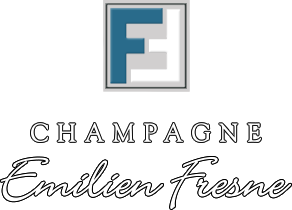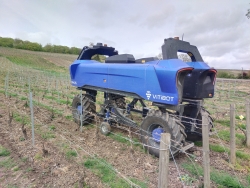Open everyday by appointment.

Winemaking in Champagne
Winemaking methods are specific to AOC (controlled designation of origin) Champagne. This is what makes the specificity of Champagne.
Champagne winemaking has 6 crucial steps.
1. Pressing
Pressing is gentle and progressive, to preserve the quality. In Champagne, wine press are adapted to black grapes with white juice (pinot meunier and pinot noir). It crushes the grapes without brewing them to prevent skin pigments (also called grape must) to mix with the juice.
Our press is pneumatic. An air inflated membrane comes in to slowly crush the grapes. Pressure does not exceed 1.4 bar.
Pressing is done in several stages: it first collects the “cuvée” (the first juice and also the best, approximatively 80% in total) and finishes with the “taille” (second juice, approximatively 20%).
We are very thorough at pressing the different kind of grapes varieties separately, but also according to the parcel which they were harvested on (young, old vines…). Grape must and later wines will have their own terroir characteristics.
By making these distinctions we end up with a good range of wine tastes for our blending.
2. Winemaking
After pressing, the musts are placed in vats where they will undergrown two fermentations during a 2 to 3 weeks period.
Alcoholic fermentation: Yeasts turns the juice into wine by consuming the sugar, transforming it into alcohol and releasing carbon dioxide. These wines are called “tranquil white wines”, and they have about 11% abv.
Malolactic fermentation: Malic acid changes into lactic acid because of the selected bacteria. These fermentation enables to soften wines acidity and give them flexibility.
After the fermentation process, wine is left to rest for a couple of months. At this stage, we call it “clear wine”.
Cuvées blending
One of the Champagne’s secrets lies in the combination of the “Cuvées”. The vast majority of Champagnes are the result of wines mixtures (called “blending process”) from different years, different parcels and different varieties.
Blending is not just mixing in several tanks. It gives richness and aromatic complexity.
Blending enables to maintain a constant style, although every harvest is different in terms of quality and quantity.
This explains why we use wine from the reserve. Every year, a certain quantity of the harvest is kept in vats after the alcoholic fermentation for 2 to 3 years. These wines are blended in variable proportions with the wines from the harvest.
The art lies in the realization of a harmonious and well balanced elixir. Several tests are necessary to obtain the final result.
If the wine from a particular harvest is exceptional, we can create the blend of a Cuvée with the wine of a single year. This king of Champagne will be called “Millesime”, it represents the typicality of the year.
3. Bottling
Once the Cuvée is created, wine has to be bottled. This is the bottling process.
Before the bottling process, we prepare a leaven which consist in the multiplication of an important enough quantity of yeasts and of a “tirage liqueur” (made out of sugar and wine).
The day before bottling, the leaven is mixed with the other Cuvées (5% alcohol by volume) and the liqueur is incorporated, respecting a dose of 24g of sugar by wine liter.
Everything is made to cause a second alcoholic fermentation in the bottle.
This second fermentation will bring a carbonic gas emission inside the bottle which is closed beforehand. Pressure can go up to 5 to 6 kg and the alcohol can increase of 1.4°. The traped carbon dioxide is then dissolved in the wine. It is the “prise de mousse” (it becomes sparkling): a really delicate operation which has to be slow and at a constant temperature if we want to obtain a delicate foam and enable the development of the most subtle flavors.
4. Wines aging
Once the foam formed, the yeast dies creating sediments, the molecules of this residue interact with the wine’s molecules. Simultaneously, a gas exchange occurs with the outside. This particular process and light oxidation contributed to the evolution of aromas and the increase of gustatory Champagne qualities.
The maturation process' period varies according to the blending types and desired result, but legislation requiers a rather long minimal period compared to other sparkling wines:
- 15 months minimum after bottling, with 12 month on wooden slats, except for Millésime Champagne.
- 3 years for Millésime Champagne
In our exploitation, bottles are kept in the wine cellar for at least 3 years for classic bottles and 5 years for Millésime Champagne.
5. Riddling
When the maturation of Champagne is considered satisfying enough and before shiping the bottles, the sediment inside has to be removed. The “riddling” of the bottles is an ancestral technique that is typical in Champagne. It consists of making the sediment go down the neck of the bottle, to expell it completely. It can be done manually or automatically.
Traditional method
This technique consists of placing each bottle horizontally on a wooden desk and turning the bottle 1/8th or 1/4th every day from left to right. This movement makes the heavy sediments attract the lighter residues up to finest particles and makes the Champagne totally limpid.
In addition to this pendulum swing, the bottle is also progressively vertically positioned, making the sediments drown down the neck in the plastic “bidule”. This manual operation takes about a month.
6. Disgorgement
Then comes the disgorgement step, which consists in opening the bottle to expel the deposit accumulated during the riddling.
It is made by freezing the neck: bottles are put upside down. The neck is immersed in a -25°C solution which freezes the deposit. Then, the bottle is flipped and the cap removed. A 6 bars pressure inside the bottle expells the ice cube.
We add the “liqueur de dosage”, which finalizes the taste of a slight addition of sugar. It is the concentration in “liqueur de dosage” which makes the difference between a Champagne Brut and a Demi-Sec.
Finally comes the clogging by a cork plug maintained by a metallic "muselet".
Then the bottles are left to rest for at least 3 months.
The only step remaining is to put labels and tags on the bottles and sell them.










